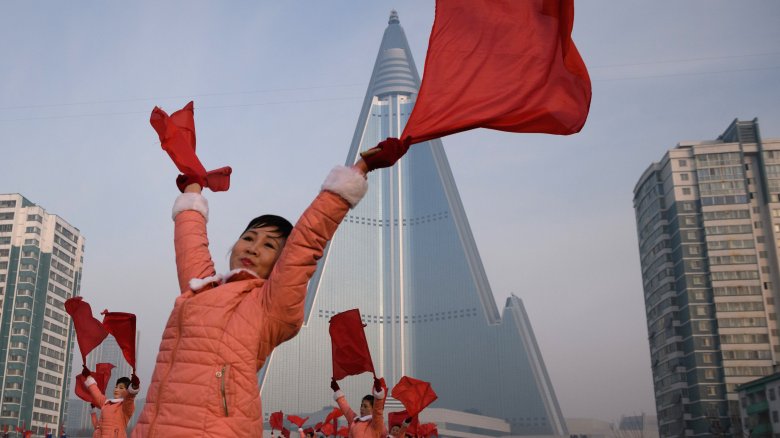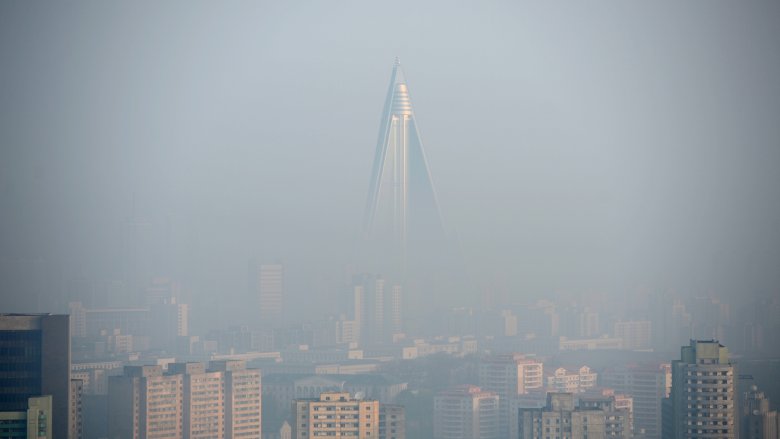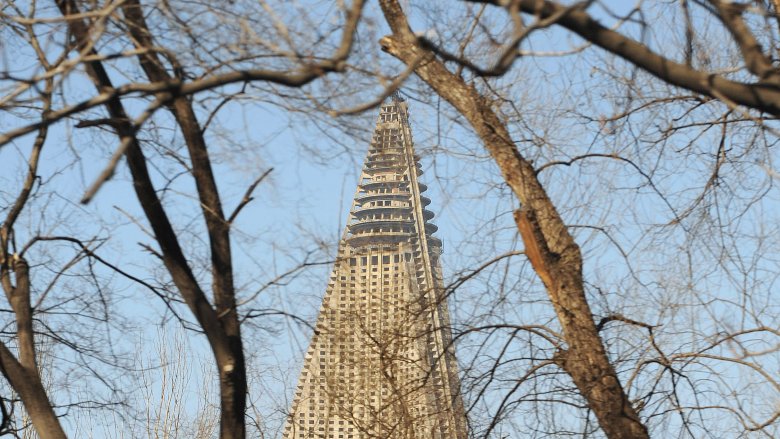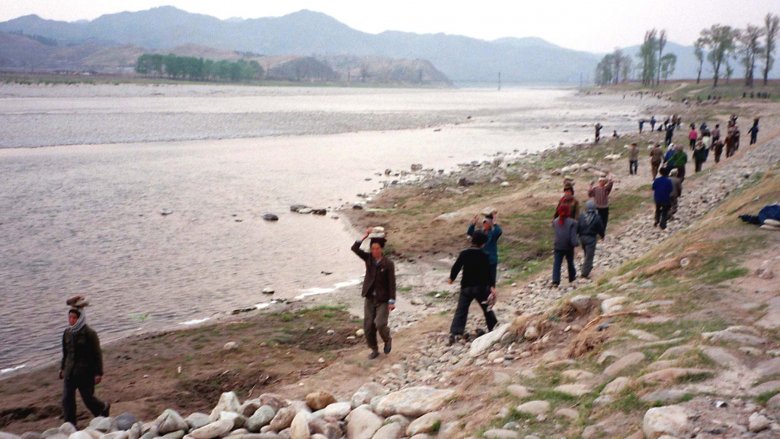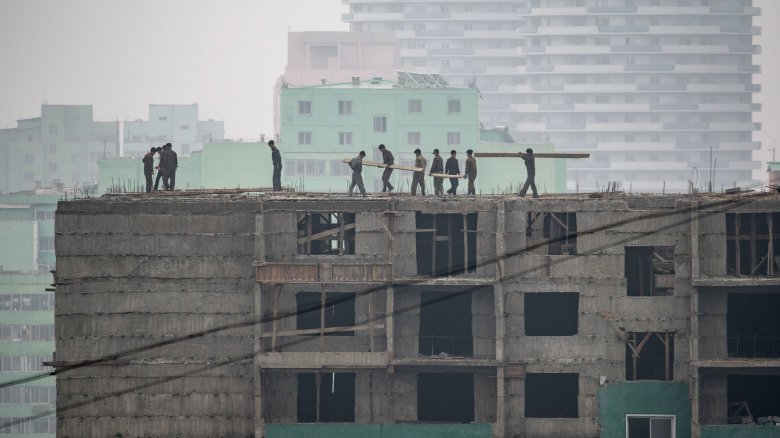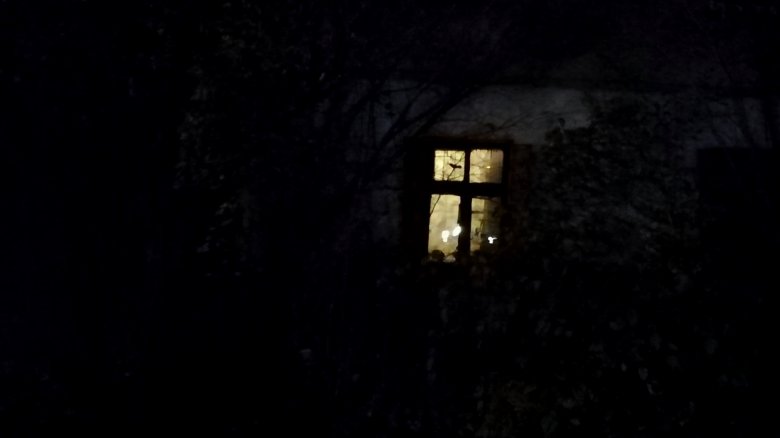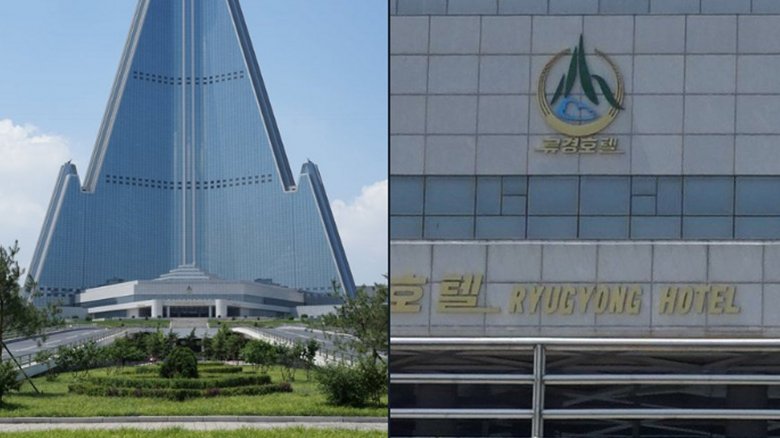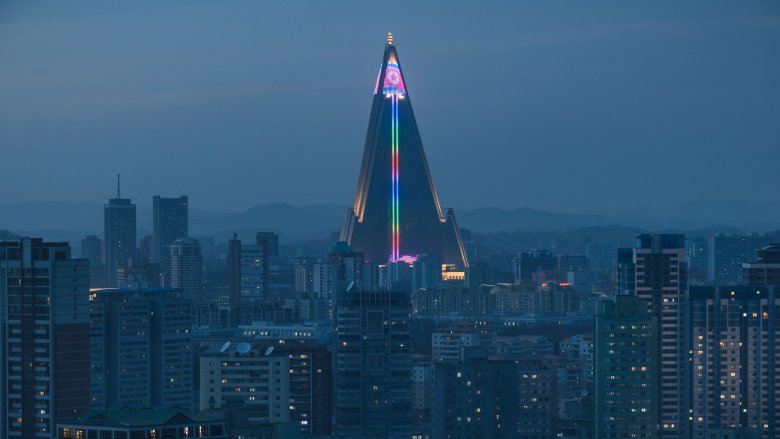The Untold Truth Of North Korea's Hotel Of Doom
If you've ever taken a gander at the skyline of North Korea's capital city, Pyongyang, it's hard to forget the triangular tower jutting out above everything else. Known as the "Hotel of Doom," this unique skyscraper is pretty much North Korea's equivalent to the Empire State Building, prominent due to both its notable height, and the light shows that play across its futuristic exterior when the sun goes down. It's an iconic fixture.
The weird part? It's empty on the inside, because the Hotel of Doom has never been completed. Despite being intended as a national symbol, the world's tallest abandoned hotel instead became a mausoleum of lost hopes. Decades of work never seems to cross the finish line. Every time that construction resumes, money gets tight, and a new problem throws the whole process awry. Is the hotel as cursed as people say? While rumors flourish, here are the facts behind the Hotel of Doom: the world's most unusual skyscraper.
What is Ryugyong, the Hotel of Doom?
Of course, no one involved in constructing the Hotel of Doom has actually called it that themselves. The building's true name, the Ryugyong Hotel, means "capital of willows," a historical marker for Pyongyang. When construction began on the massive skyscraper all the way back in 1987, it was intended to be an enduring testament to North Korea's success, dreams, and future, according to CNN. Its massive size and scale were no accident: from day one, North Korea wanted this to be the tallest building in the entire Korean peninsula, and its designation as a hotel was imagined as a place where thousands upon thousands of visitors would one day stay and (in theory) marvel at Pyongyang from above.
Ever since those high hopes first erected the Ryugyong Hotel into the sky, no guests have ever stayed there. Initial construction halted in 1992, and though it occasionally resumes, the hotel has, so far, never opened. The building, now outfitted with a futuristic metal and glass skin, is an empty shell. As opposed to the achievements that the original designers might have hoped for, the hotel now holds a Guinness World Record as the tallest unoccupied building in the world.
The Hotel of Doom's fascinating architectural design, explained
Now, sure, the world is full of abandoned hotels. There's none as weird as this one, however. The building's sheer size and scale is, unto itself, deeply impressive: as Atlas Obscura remarks, each of the three triangular structures that makes up the structure are 100 meters (about 328 feet) long. The building's floor space is big enough to house 67 football fields. 3,000 bedrooms were planned for the hotel, as well as seven revolving restaurants placed at the summit. As far as comparisons go, the Ryugyong is ridiculously bigger than the Statue of Liberty, and has a similar height to the Eiffel Tower. Building the hotel, needless to say, was a seriously ambitious undertaking.
Nowhere is that dream more evident than in the building's fascinating architecture itself. Often compared to a pyramid, insiders believe that the Ryugyong is actually modeled after a mountain, according to CNN, which is an important cultural symbol in North Korea, even depicted in the national emblem. Aesthetics and meaning aside, the design's uniqueness is also about function: Unlike the world's other skyscrapers, North Korea's tower was constructed from reinforced concrete, instead of steel, which requires the top sections to be lighter than the bottom ones. All these factors, when combined, resulted in the striking design now synonymous with Pyongyang's skyline.
However, the inside of the hotel is another story altogether.
The inside of the Hotel of Doom is ghostly
For a project that first got underway in the eighties, it's rather shocking that—all these decades later—the inside of the Ryugyong is so eerily abandoned.
For most of the hotel's unfinished lifespan, observers could only guess at what work might have been done on the interiors, but that all changed in 2012 when a report by NK News revealed a series of creepy photographs showing that, if the hotel ever were to open, there was still a lot of work to do. It seems that every room inside the Ryugyong is barren. Concrete stairs lead to undecorated windows, would-be meeting spaces are empty, and other signs of unrealized ambition are everywhere. According to CNN, the only working elevator that moves between all 99 floors is an old fashioned service elevator, requiring a human lift operator to be present: One presumes that, on most days, said operator isn't there, since there's usually nobody inside the building. The small batch of revealing photos the world has today were taken by Simon Cockerell, a manager at the Beijing-based company Koryo Group, who was only allowed inside as a birthday gift. (Weird choice of present, but whatever.)
Ghostliness aside, all the work done to the hotel's innards show a construction project that, on multiple occasions, had seemed on the way to completion ... only for something to go horribly wrong.
How this strange Hotel of Doom project first began
When it comes to so many of the messy, tangled, and/or catastrophic things in the 21st century, you can often safely assume the Cold War between the U.S. and Soviet Union had something to do with it. Without delving too far into the nitty-gritty, the thing you need to know is Cold War tensions — and the resulting rivalry between North and South Korea — were the match that lit this powder keg of a construction project.
In 1986, according to Atlas Obscura, a South Korean group built a massive hotel in Singapore, which was (at the time) the tallest building in Asia. North Korea was not okay with their rivals pulling off this feat, so in 1987, they began constructing a taller, bigger, better building. Guess what it was? Bingo, the Ryugyong Hotel.
The New York Times reports tensions further escalated in 1988, when South Korea hosted the Summer Olympics. Aghast, North Korea decided to pour all of their resources into their own "Olympic" games, the so-called World Festival of Youth and Students. Hoping to bring in swarms of visitors and attract international attention, North Korea invested an estimated $4 billion in downtown expansions, airport modifications, a sparkling new May Day Stadium to host the games ... and, yes, trying to finish their super-impressive Ryugyong Hotel project, so tourists could swoon at it when they arrived. If the project were completed, it would've been the tallest hotel in the world.
Famine, flooding, and money problems
Unfortunately for North Korea, their big plans got roadblocked by that all too mundane — but terrifying — opponent, a dwindling bank account. According to the New York Times, the nation was already struggling to afford all the massive infrastructure projects, and while the big Pyongyang festival did make it through the gates (with an incomplete tower), what was supposed to be a victorious opening statement instead become a dire warning of what was soon to come: within a few years, the Soviet Union collapsed, thereby lopping off North Korea's prime source of economic aid. Around the same time, North Korea's agricultural industry was pummeled by floods, droughts, and other climate catastrophes. Famine struck, and most of the country soon found itself starving for basic necessities like food and water. Horrifyingly massive swaths of the North Korean population died from starvation, rendering moot any enthusiasm for any more ambitious projects like the World Festival of Youth and Students.
And in the middle of it all, ominously, stood the Ryugyong.
Though the hotel's construction sailed right past its original 1989 opening date, according to Atlas Obscura, work on the project kept plugging away until the onset of famine in the nineties. Between funding issues and electrical shortages, the expensive hotel—at this point, it had cost about $750 million USD — no longer seemed so important, even though work on the external structure had been completed. The project was canned in 1992, and construction crews sent home.
Better to pretend the Hotel of Doom is not there (as long as nobody notices)
Thus, for the next 16 years, the tower of dreams became the abandoned Hotel of Doom. By the time that construction work was called off, the hotel's eerie skeleton was left poking up into the sky, like the world's largest empty, windowless haunted house, according to CNN. Efforts were abandoned so quickly that a crane was left standing atop the building, and the equipment's dinosaurian neck, lifted high over Pyongyang, served as an increasingly rusty reminder of the project's failure.
During this time, North Korea saw the whole thing as a massive embarrassment, which they preferred to hide from the world. Despite the landmark's massive size, ABC News says that it was ignored on all official maps, left out of sightseeing guides, and led to subject changes whenever it was brought up. According to the Los Angeles Times, North Korea even went so far as to airbrush the hotel's jutting spiked tip out of Pyongyang photographs. Not the most convincing tactic.
Construction on the Hotel of Doom resumes!
Suddenly, in 2008, the buzzing sounds of construction equipment filled the streets of Pyongyang. As reported by the Los Angeles Times, new apartments and office structures rose into the sky. Tram lines were replaced. Theaters went up. Old structures were modernized, in a bid for tourism. And most impressive of all, the Hotel of Doom transformed from abandoned ghost tower into, once again, an active project.
Gleaming glass panels were installed all over the Ryugyong, according to the BBC, turning the infamous eyesore into the futuristic, spaceship-like structure it is today. There were some rather pertinent questions regarding how North Korea was paying for this whole shebang—even though the country claimed to be funding its own renovation efforts, their economy was still recovering from those deathly famines in the nineties—but nonetheless, construction efforts moved forward quickly. The publicly proclaimed goal was to have the Ryugyong Hotel finally complete and open for business by April 15th, 2012, for the 100th anniversary celebration of the birth of Kim Il Sung, the "eternal president" and founding leader of North Korea.
Oh boy, there goes the deal
As it happens, the company in charge of the process of finishing up the infamous hotel, as part of a $400 million deal with a local North Korean firm, was the Egyptian tech giant Orascom Telecom. The BBC reported that Orascom's first goal was to finish polishing up the outside, then move to building up the inside: finally, Orascom planned to install antennas and other mobile networking equipment at the very top of the tower, so that the Egyptian company could setup (and be in charge of) 3G mobile phone access to North Korea.
$180 million was spent on the effort, according to CNN. The rusty crane was finally taken down from the rooftop, much to everyone's relief. By 2011, the exterior was nice and shiny. In 2012, a Germany hotel company named Kempinski proclaimed that they'd finally be opening up the Ryugyong Hotel for guests, under their management, within a year. Then ... once again, it all came crashing down. Just a few months later, Kempinski cancelled the deal, giving sparse details on why.
Once again, the Ryungyung was abandoned. No other companies expressed interest, the hotel never opened its doors, and for the next few years, no further activity was reported.
The sleeping behemoth stirs back to life
More years of emptiness went by, but in December of 2016, signs of activity lit up the Hotel of Doom once again. Literally.
Though rumors of the Ryugyong Hotel opening for business have always come and gone, the first major indicator that something might truly be happening, according to the Telegraph, was when there was a report of a light spotted inside the hotel. That's a big deal, for a building with no electricity. No further revelations came until a year later, when a series of satellite images showed that cranes and building trucks were parked and roaming around the building, presumably getting to work. Meanwhile, tourists who visited North Korea claimed that their tour guides were boasting that the hotel would soon open offices or public exhibits in the near future.
The forward motion was undeniable, for a project that had been DOA so many times, but media responses were muted. Was the Hotel of Doom finally getting off the ground ... at least, in a small way? Or was this yet another false start? What came next, admittedly, wasn't what anyone expected.
The extravagant light show cometh
In December of 2018, the seemingly abandoned Ryugyong Hotel was reborn as a symbol of the country's history ... albeit, in a manner quite different than the original architects may have envisioned.
Every evening, as reported by the Associated Press, North Korea's tallest building began lighting up the night for several hours at a time, with extravagant show of colors and images created via 100,000 LED bulbs. This nightly light show — which mostly displays party slogans, logos, North Korean monuments, the flag, and various other propaganda animations— totally altered the Pyongyang skyline, and markedly changed the Ryugyong Hotel's reputation. The glistening array of imagery, which lasts about four minutes and can reportedly be stored in an SD card and put into a computerized controlling system the size of a regular DVD player, is the creation of light designer Kim Yong-il, who is the vice-department director of the Korean Light Decoration Center. When interviewed, he boasted that, "I made this magnificent design for this gigantic building and when people see it, it makes them feel good. It makes me proud to work as a designer."
One thing that the light designer wasn't so sure about? When the hotel itself will be open for business. When asked to make a guess, he simply laughed it off as not being his field.
Dark secrets, cover-ups, and detention
On June 24th, 2019, a young Australian man named Alek Sigley tweeted the above two images, showing that new signage had been erected outside the hotel's doors. What happened next was horrifying.
Three days later, Sigley vanished into thin air. His family were unable to get a hold of him via Whatsapp, according to News.com,au, and the Guardian reported that his friends couldn't reach him on Skype. Sigley, at the time, was rooted to North Korea in multiple ways: not only had he married his Japanese-born wife in Pyongygang, but he was also a student at the local university, and the founder of the North Korean tour group Tongil Yours. He was believed to be the only Australian living in North Korea.
Soon, it became apparent that Sigley had been detained by the North Korean authorities, for unclear reasons. His loved ones were terrified that he may have suffered the same fate as Otto Warmbier—the 22-year-old American tourist who was imprisoned by the North Korean government in 2016, and released a 18 months later with severe brain damage—but thankfully, Sigley was released from imprisonment only a week later. He flew to Beijing, followed by Tokyo, leaving North Korea behind. When Sigley was inquired about what had happened to him during the seven days he was detained, he said through a spokesperson that he intends to never discuss it, and would prefer that the media respect his right to privacy.
Will Ryugyong, the Hotel of Doom ever open?
Between the stops, starts, propaganda, and disturbing human rights violations, the question of when — or if — the Ryugyong Hotel will ever truly open remains unresolved. The nightly light shows are definitely a big change, and Sigley's tweeted pictures certainly indicate that the process is moving forward, to some degree ... but if so, why was he imprisoned so soon afterward? Was it connected? The mystery remains unresolved.
However, North Korea is certainly planning to develop the area. In 2019, according to NK News, the Korean Central Television network started promoting grand plans for rebuilding the district surrounding the hotel's base. Whether these ambitions are someday realized or not, of course, is another question entirely. Are the funds there? Will this be another false start? Whatever might happen, it does seem like North Korea wants to aggressively dedicate more resources toward developing the formerly long-lost hotel, particularly now that the new light show has rendered it as the grand centerpiece of the city. So, stay tuned.
